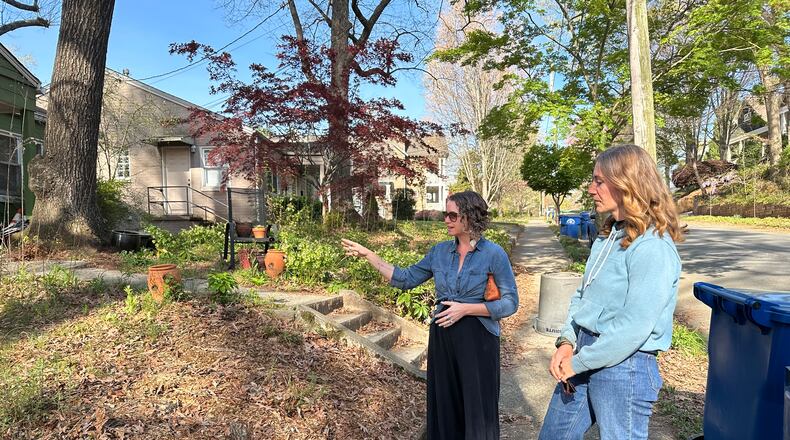Every year around this time, I join legions of metro Atlanta residents who scroll the neighborhood chats seeking recommendations for lawn care.
Mostly, people just want someone reliable who will show up and do a decent job. It doesn’t feel like it should be that hard but in almost 10 years, I’ve had almost as many lawn guys.
Even though I am the least demanding client on Earth, I have good information that my yard isn’t the easiest to maintain.
There’s some interesting terrain — misplaced flowers and plants, roots from long-lost trees, soil erosion, a giant rock feature, some fast-growing weeds and a random metal pipe that pokes about an inch out of the ground — all of which make the job harder than it should be.
So, on the first day of spring, as Atlanta’s pollen counts began creeping toward historic levels, I spent four hours hand-weeding my side lawn. I knew I was ready for something new. I am never going to have a perfectly manicured lawn, so maybe it’s time for me to embrace the lazy lawn movement, a form of low-maintenance lawn care that encourages natural growth and is more beneficial to plants and insects.
Credit: Erik Meadows
Credit: Erik Meadows
As my fellow Atlanta Journal-Constitution columnist Bill Torpy recently reported, attempts at this type of sustainable landscaping can quickly turn into a visit from code enforcement depending on where you live.
Times are changing faster than the law in some parts of town, particularly suburban neighborhoods or planned communities with strict homeowners association rules.
You’re likely to see more sustainable landscaping in intown neighborhoods than in Sandy Springs for example but since the COVID-19 pandemic, more residents across the metro area have become receptive to the idea.
Lazy lawns are about more than just saving time; they can also save pollinators and wildlife, conserve water and limit chemical exposure to pets or children.
Sustainable landscaping has long been a trend on the West Coast where concerns about water conservation helped promote the movement’s popularity. And if we’re being honest, Atlanta has some major water issues as well.
Though we have long been wedded to the idea of a traditional lawn, there is a way to balance our need for certain aesthetics with preserving the planet and its resources. But a neglected yard is not the same as creating a biodiverse yard, even if the two are sometimes confused.
“You can have spaces that are wild but if they’re framed in a way that looks intentional, I think it is easier and it’s more legible,” said Brandy Hall, CEO of Shades of Green Permaculture. “There can be an incorporation of hardscapes with wild beds around them … that goes a long way for being able to have areas where it grows a little longer but doesn’t look like it is neglected.”
Hall started working in Atlanta in 2010, when people were still hesitant to put vegetable gardens in their front yards because they were too utilitarian and when permaculture was synonymous with blue tarps, wooden pallets and roadkill.
I met up with Hall and caretaking director Roxy Drew in my neighborhood, an area of town where they have a solid client base. We walked around observing some of the efforts to go wild and they helped me understand how much thought and effort goes into creating spaces that look effortless but also organized.
Credit: Virginie Kippelen
Credit: Virginie Kippelen
A complete landscape design and installation can cost tens of thousands of dollars, making it cost-prohibitive to some homeowners. This could be the reason that some Atlanta residents resort to a hands-off approach — assuming that if it grows, it goes.
But most of us need lessons on how to manipulate nature to give us what we want, whether that is more birds and butterflies or microclimates with plants suited to the temperature of the soil.
We can create patterns that are pleasing to the eye by repeating swathes of colors, textures and patterns throughout the landscape so the design looks intentional rather than haphazard.
When you listen to nature, it can tell you what it needs: ground cover or mulch to crowd out weeds or stones to redirect water and prevent erosion. Instead of raking leaves each fall, as many of us do, leaving them at the base of trees to cover tree roots in the winter helps put nutrients back into the soil. Hall and Drew said they have used an immersion blender to crush the leaves before scattering them, just to make it more visually pleasing.
As we walked, we saw wild-growth gardens that were lush but were filled with non-native plants, even when there were native plants with a similar aesthetic. Hall said introducing just a little more biodiversity and making space for more native species can make a big difference.
I used to chide one of my neighbors about his lazy lawn but by the time we reached his house, Hall and Drew had guided me to see the beauty that was unfolding in his yard and how small changes could make it even more attractive.
Permaculture isn’t for everyone, maybe not even for me. But now I view wild growth yards with new eyes and a deeper understanding of why we need them in our city.
Read more on the Real Life blog (AJC.com/opinion/real-life-blog), find Nedra on Facebook (facebook.com/AJCRealLifeColumn) and X (@nrhoneajc) or email her at nedra.rhone@ajc.com.
About the Author
Keep Reading
The Latest
Featured





